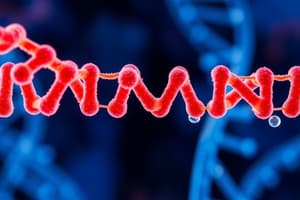Podcast
Questions and Answers
What initiates the formation of a thymine dimer in DNA?
What initiates the formation of a thymine dimer in DNA?
- Enzymatic activity from photolyase
- Exposure to visible light
- Chemical reactions with nucleotides
- Exposure to ultraviolet light (correct)
What is the role of photolyase in the repair process of thymine dimers?
What is the role of photolyase in the repair process of thymine dimers?
- It absorbs blue light to break the dimer. (correct)
- It prevents the dimer from forming.
- It synthesizes new nucleotides to fill the gap.
- It cuts out the dimer from the DNA strand.
What is the first step of nucleotide excision repair after the thymine dimer has been recognized?
What is the first step of nucleotide excision repair after the thymine dimer has been recognized?
- Helicase unwinds the DNA.
- Nuclease cuts the strand. (correct)
- DNA polymerase fills in the gap.
- The damaged section is removed.
What ultimately restores normal pairing after photorepair of a thymine dimer?
What ultimately restores normal pairing after photorepair of a thymine dimer?
Which step is NOT part of the nucleotide excision repair process?
Which step is NOT part of the nucleotide excision repair process?
What type of light is specifically utilized in the photoreactivation repair process?
What type of light is specifically utilized in the photoreactivation repair process?
What happens to the DNA double helix due to the formation of a thymine dimer?
What happens to the DNA double helix due to the formation of a thymine dimer?
What is the final step in the nucleotide excision repair process?
What is the final step in the nucleotide excision repair process?
What is the role of DNA ligase in DNA repair?
What is the role of DNA ligase in DNA repair?
Which enzyme is crucial for breaking the cyclobutane ring in thymine dimers?
Which enzyme is crucial for breaking the cyclobutane ring in thymine dimers?
What triggers the activation of photolyase during the repair of thymine dimers?
What triggers the activation of photolyase during the repair of thymine dimers?
In excision repair, which enzyme is responsible for cutting the DNA strand on either side of the thymine dimer?
In excision repair, which enzyme is responsible for cutting the DNA strand on either side of the thymine dimer?
What occurs during the SOS repair mechanism after the creation of thymine dimers?
What occurs during the SOS repair mechanism after the creation of thymine dimers?
What happens to the exonuclease during the excision repair pathway?
What happens to the exonuclease during the excision repair pathway?
Which process involves recombination to cope with the presence of thymine dimers?
Which process involves recombination to cope with the presence of thymine dimers?
What characterizes the thymine dimer formation process?
What characterizes the thymine dimer formation process?
Flashcards are hidden until you start studying
Study Notes
Thymine Dimers
- UV light can cause the formation of thymine dimers in DNA.
- Thymine dimers are formed when two adjacent thymine bases in a DNA strand bond to each other.
- This bonding alters the structure of DNA causing a kink in the double helix.
Repairing Thymine Dimers
- Two main repair pathways exist: Nucleotide excision repair and photoreactivation.
- Nucleotide excision repair removes the damaged segment of DNA containing the thymine dimer.
- Enzymes involved include nucleases, helicases, DNA polymerase I and DNA ligase.
- Photoreactivation uses blue light to break the bond between the two thymine bases in the dimer.
- The enzyme photolyase binds to the dimer and uses blue light energy to split the dimer.
Photoreactivation Repair
- Photolyase is a key enzyme in photoreactivation repair.
- Excision repair involves the removal of the thymine dimer by an enzyme encoded by the uvr gene.
- Both photoreactivation and excision repair restore the original structure of DNA.
Photoactivation for Repair of Thymine Dimer
- Photolyase can absorb visible light and use this energy to break the cyclobutane ring connecting the thymine dimer bases.
- This process releases the photolyase from the DNA and repairs the damaged DNA strand.
Cleavage of Thymine Dimer Crosslinks by Photoreactivation
- Photoreactivation is a process where the photolyase enzyme binds to a thymine dimer and uses blue light energy to cleave the dimer.
- This process restores the original structure of the DNA by breaking the bond between the two thymine bases.
Diagram of the Excision Repair Pathway
- The excision repair pathway involves several steps:
- Recognition of the thymine dimer by enzymes.
- Cutting the DNA strand on either side of the dimer.
- Removal of the damaged segment containing the dimer.
- Filling the gap with new nucleotides by DNA polymerase.
- Sealing the gap by DNA ligase.
Simplified version of Postreplication Recombination Repair
- Postreplication recombination repair is a process that uses a sister chromosome as a template to repair a damaged DNA strand.
- This repair pathway is used when DNA polymerase is unable to replicate past a thymine dimer.
SOS Repair
- SOS repair is a last-ditch effort to repair damaged DNA.
- It is an error-prone process, meaning it can introduce mutations in the DNA.
- SOS repair is activated when other repair systems fail to repair damaged DNA.
Studying That Suits You
Use AI to generate personalized quizzes and flashcards to suit your learning preferences.



